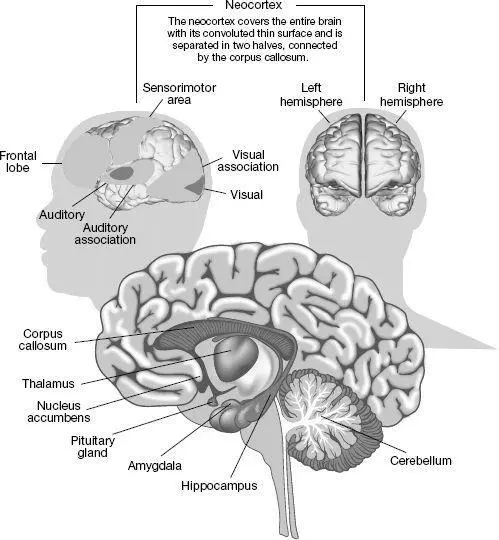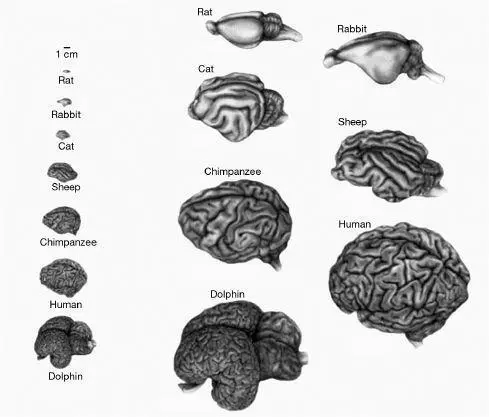In 2003 and 2004, PalmPilot inventor Jeff Hawkins and Dileep George developed a hierarchical cortical model called hierarchical temporal memory. With science writer Sandra Blakeslee, Hawkins described this model eloquently in their book On Intelligence . Hawkins provides a strong case for the uniformity of the cortical algorithm and its hierarchical and list-based organization. There are some important differences between the model presented in On Intelligence and what I present in this book. As the name implies, Hawkins is emphasizing the temporal (time-based) nature of the constituent lists. In other words, the direction of the lists is always forward in time. His explanation for how the features in a two-dimensional pattern such as the printed letter “A” have a direction in time is predicated on eye movement. He explains that we visualize images using saccades, which are very rapid movements of the eye of which we are unaware. The information reaching the neocortex is therefore not a two-dimensional set of features but rather a time-ordered list. While it is true that our eyes do make very rapid movements, the sequence in which they view the features of a pattern such as the letter “A” does not always occur in a consistent temporal order. (For example, eye saccades will not always register the top vertex in “A” before its bottom concavity.) Moreover, we can recognize a visual pattern that is presented for only a few tens of milliseconds, which is too short a period of time for eye saccades to scan it. It is true that the pattern recognizers in the neocortex store a pattern as a list and that the list is indeed ordered, but the order does not necessarily represent time. That is often indeed the case, but it may also represent a spatial or higher-level conceptual ordering as I discussed above.
The most important difference is the set of parameters that I have included for each input into the pattern recognition module, especially the size and size variability parameters. In the 1980s we actually tried to recognize human speech without this type of information. This was motivated by linguists’ telling us that the duration information was not especially important. This perspective is illustrated by dictionaries that write out the pronunciation of each word as a string of phonemes, for example the word “steep” as [s] [t] [E] [p], with no indication of how long each phoneme is expected to last. The implication is that if we create programs to recognize phonemes and then encounter this particular sequence of four phonemes (in a spoken utterance), we should be able to recognize that spoken word. The system we built using this approach worked to some extent but not well enough to deal with such attributes as a large vocabulary, multiple speakers, and words spoken continuously without pauses. When we used the technique of hierarchical hidden Markov models in order to incorporate the distribution of magnitudes of each input, performance soared.
CHAPTER 4
THE BIOLOGICAL NEOCORTEX
Because important things go in a case, you’ve got a skull for your brain, a plastic sleeve for your comb, and a wallet for your money.
George Costanza, in “The Reverse Peephole” episode of Seinfeld
Now, for the first time, we are observing the brain at work in a global manner with such clarity that we should be able to discover the overall programs behind its magnificent powers.
J. G. Taylor, B. Horwitz, and K. J. Friston
The mind, in short, works on the data it receives very much as a sculptor works on his block of stone. In a sense the statue stood there from eternity. But there were a thousand different ones beside it, and the sculptor alone is to thank for having extricated this one from the rest. Just so the world of each of us, howsoever different our several views of it may be, all lay embedded in the primordial chaos of sensations, which gave the mere matter to the thought of all of us indifferently. We may, if we like, by our reasonings unwind things back to that black and jointless continuity of space and moving clouds of swarming atoms which science calls the only real world. But all the while the world we feel and live in will be that which our ancestors and we, by slowly cumulative strokes of choice, have extricated out of this, like sculptors, by simply rejecting certain portions of the given stuff. Other sculptors, other statues from the same stone! Other minds, other worlds from the same monotonous and inexpressive chaos! My world is but one in a million alike embedded, alike real to those who may abstract them. How different must be the worlds in the consciousness of ant, cuttle-fish, or crab!
William James
Is intelligence the goal, or even a goal, of biological evolution? Steven Pinker writes, “We are chauvinistic about our brains, thinking them to be the goal of evolution,” 1 and goes on to argue that “that makes no sense…. Natural selection does nothing even close to striving for intelligence. The process is driven by differences in the survival and reproduction rates of replicating organisms in a particular environment. Over time, the organisms acquire designs that adapt them for survival and reproduction in that environment, period; nothing pulls them in any direction other than success there and then.” Pinker concludes that “life is a densely branching bush, not a scale or a ladder, and living organisms are at the tips of branches, not on lower rungs.”
With regard to the human brain, he questions whether the “benefits outweigh the costs.” Among the costs, he cites that “the brain [is] bulky. The female pelvis barely accommodates a baby’s outsized head. That design compromise kills many women during childbirth and requires a pivoting gait that makes women biomechanically less efficient walkers than men. Also a heavy head bobbing around on a neck makes us more vulnerable to fatal injuries in accidents such as falls.” He goes on to list additional shortcomings, including the brain’s energy consumption, its slow reaction time, and the lengthy process of learning.
While each of these statements is accurate on its face (although many of my female friends are better walkers than I am), Pinker is missing the overall point here. It is true that biologically, evolution has no specific direction. It is a search method that indeed thoroughly fills out the “densely branching bush” of nature. It is likewise true that evolutionary changes do not necessarily move in the direction of greater intelligence—they move in all directions. There are many examples of successful creatures that have remained relatively unchanged for millions of years. (Alligators, for instance, date back 200 million years, and many microorganisms go back much further than that.) But in the course of thoroughly filling out myriad evolutionary branches, one of the directions it does move in is toward greater intelligence. That is the relevant point for the purposes of this discussion.

Physical layout of key regions of the brain.

The neocortex in different mammals.
Suppose we have a blue gas in a jar. When we remove the lid, there is no message that goes out to all of the molecules of the gas saying, “Hey, guys, the lid is off the jar; let’s head up toward the opening and out to freedom.” The molecules just keep doing what they always do, which is to move every which way with no seeming direction. But in the course of doing so, some of them near the top will indeed move out of the jar, and over time most of them will follow suit. Once biological evolution stumbled on a neural mechanism capable of hierarchical learning, it found it to be immensely useful for evolution’s one objective, which is survival. The benefit of having a neocortex became acute when quickly changing circumstances favored rapid learning. Species of all kinds—plants and animals—can learn to adapt to changing circumstances over time, but without a neocortex they must use the process of genetic evolution. It can take a great many generations—thousands of years—for a species without a neocortex to learn significant new behaviors (or in the case of plants, other adaptation strategies). The salient survival advantage of the neocortex was that it could learn in a matter of days. If a species encounters dramatically changed circumstances and one member of that species invents or discovers or just stumbles upon (these three methods all being variations of innovation) a way to adapt to that change, other individuals will notice, learn, and copy that method, and it will quickly spread virally to the entire population. The cataclysmic Cretaceous-Paleogene extinction event about 65 million years ago led to the rapid demise of many non-neocortex-bearing species that could not adapt quickly enough to a suddenly altered environment. This marked the turning point for neocortex-capable mammals to take over their ecological niche. In this way, biological evolution found that the hierarchical learning of the neocortex was so valuable that this region of the brain continued to grow in size until it virtually took over the brain of Homo sapiens .
Читать дальше














